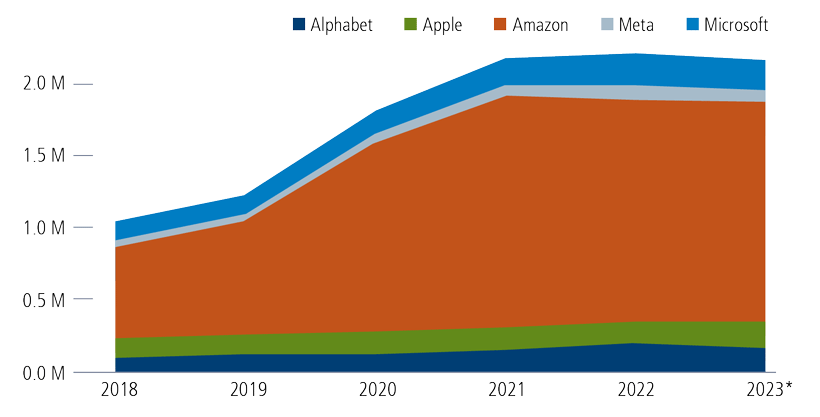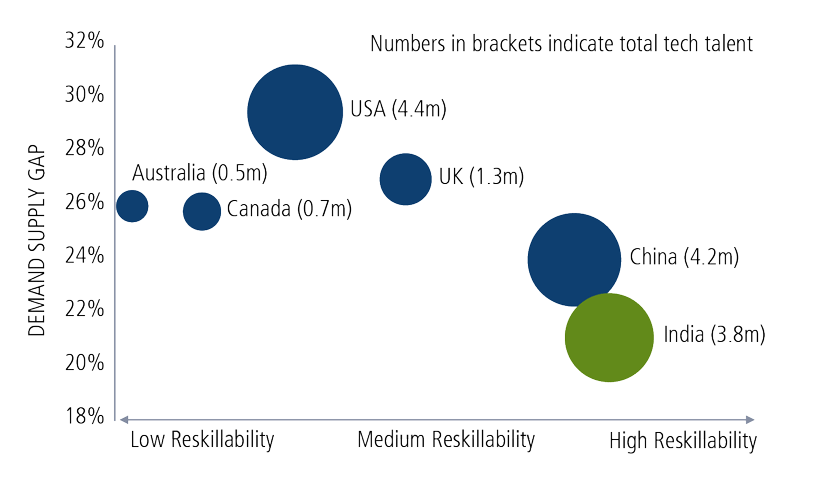 Investment Team Voices Home Page
Investment Team Voices Home Page
Tech Layoffs Create Talent Opportunities for International Firms
Alex Wolf, CFA
- Loosening Big Tech's labor stronghold may help level the global playing field.
- We believe many of our international holdings will be able to capitalize on dislocated labor markets.
- International investing offers the opportunity to access markets with technology innovators who aren’t over-indexed to the large companies now entering a period of retrenchment.
Technology layoffs continue to make headlines by the day, and there is no doubt that the dynamics of working in the industry have changed dramatically in the past few months. With the era of free money coming to an abrupt halt, technology companies across the spectrum are adapting. On quarterly conference calls, management rhetoric has shifted from a focus on growth at all costs to discussions of cost efficiencies and spend rationalizations. Although this shift will have far-reaching implications for a variety of sectors and downstream providers, it will have its greatest long-standing impact on the labor market in the tech industry.
However, this shift in mindset toward more rational spending will likely be positive for the sector over the long term. The IT labor market has been extremely tight for years because large companies have been hoarding talent and developers, so the slightest loosening of that labor pool could have significant ripple effects. Despite the growing number of layoffs, by all accounts the tech sector remains an area of healthy employment metrics relative to the broader economy.
Big Tech’s Head Count over Five Years

Source: USA Today, February 7, 2023, using company reports. *Data reflects the latest annual headcounts for each company except for 2023 which is based off estimates. Apple data is reflective of what the company considers full-time equivalent employees.
Big Tech in the US is clearly at the center of these recent employment trends, and the news of even long-tenured employees being let go could have lasting repercussions on these firms’ culture and prestige. With the center of tech talent potentially broadening away from a historically narrow focus on Silicon Valley, we see new reasons to be optimistic for many international companies. With any sudden transformation and disruption of an industry, new opportunities will arise, and companies prepared to seize the moment will prosper. Looking through this lens, we believe many of our international holdings will be able to navigate this situation to their benefit.
Loosening Big Tech’s Labor Stronghold Levels the Global Playing Field
Many tech firms have long bemoaned competing against large US players when it comes to recruitment. Whether it’s huge stock-based compensation, which international companies typically can’t match, or vying for top-tier university relationships, the competitive dynamic in recent years has pushed many companies to either hire less aggressively or pursue alternative, cheaper strategies.
Given the new reality of surplus talent available, we have met with and heard from companies that are excited to finally recruit for and fill open roles that have long been impossible to fill. Other companies that built differentiated strategies to adapt to labor scarcity through the years are likewise in strong positions. As examples, some companies targeted specific universities that are less well known but produce quality graduates. Talent pools in emerging markets can provide competitive advantages as well. Within IT services, some companies have invested in Latin America and Central and Eastern Europe over the past several years, given they offer unique channels for talent. In addition to regions, developing industry-specific expertise is another way that smaller firms can differentiate themselves. Cross-training is yet another consideration for growing talent. For example, we are invested in companies that have found ways to train non-IT labor in software-specific roles—something highly useful in a market like this one.
Global Tech Talent Landscape

Source: Nasscom/Draup, Jefferies
Unfortunately, another negative repercussion of the current environment is that H-1B visa holders are stuck in limbo after layoffs and are forced to find employer sponsors on a strict timeline. All of these factors have the potential to spread IT talent around the world. Last, US tech companies limiting their spending on moon-shot-type projects could level the playing field for Chinese companies investing in similar areas.
Ultimately, the current environment in the tech labor market has already created a lot of disruption. Just how far the disruption goes will be dependent on a variety of macroeconomic factors. The era of free money and low interest rates advantaged those who were able to spend aggressively, especially on IT talent. With that scenario unwinding now, we believe there are many companies based outside the US that are well equipped to navigate the new landscape.
Opinions, estimates, forecasts, and statements of financial market trends that are based on current market conditions constitute our judgment and are subject to change without notice. The views and strategies described may not be appropriate for all investors. References to specific securities, asset classes and financial markets are for illustrative purposes only and are not intended to be, and should not be interpreted as, recommendations.
As a result of political or economic instability in foreign countries, there can be special risks associated with investing in foreign securities, including fluctuations in currency exchange rates, increased price volatility and difficulty obtaining information. In addition, emerging markets may present additional risk due to the potential for greater economic and political instability.
18100 0223
Cookies
This website uses cookies. By continuing to use this website, you consent to the use of cookies. Learn more about our cookie usage.

